Simulating Near-Surface Winds in Europe with the WRF Model: Assessing Parameterization Sensitivity Under Extreme Wind Conditions
Abstract
1. Introduction
2. Methods
2.1. Data and Model Configuration
2.2. Experimental Design
3. Results
3.1. Model Performance Evaluation
3.2. Sensitivity Experiments
4. Summary and Conclusions
Author Contributions
Funding
Institutional Review Board Statement
Informed Consent Statement
Data Availability Statement
Acknowledgments
Conflicts of Interest
References
- DeCastro, M.; Salvador, S.; Gómez-Gesteira, M.; Costoya, X.; Carvalho, D.; Sanz-Larruga, F.J.; Gimeno, L. Europe, China and the United States: Three different approaches to the development of offshore wind energy. Renew. Sustain. Energy Rev. 2019, 109, 55–70. [Google Scholar] [CrossRef]
- Europe, W. Wind Energy in Europe: 2023 Statistics and the Outlook for 2024–2030. Available online: https://windeurope.org/intelligence-platform (accessed on 21 March 2024).
- Panciatici, P.; Leader, W.; Pache, C.; Maeght, R.; Weber, R. E-Highway 2050 Modular Development Plan of the Pan-European Transmission System 2050; European Commission: Brussels, Belgium, 2016. [Google Scholar]
- Wang, J.; Qin, S.; Jin, S.; Wu, J. Estimation methods review and analysis of offshore extreme wind speeds and wind energy resources. Renew. Sustain. Energy Rev. 2015, 42, 26–42. [Google Scholar] [CrossRef]
- Wang, K.; Hansen, M.O.L.; Moan, T. Dynamic analysis of a floating vertical axis wind turbine under emergency shutdown using hydrodynamic brake. Energy Procedia 2014, 53, 56–69. [Google Scholar] [CrossRef]
- Chen, X.; Li, C.; Tang, J. Structural integrity of wind turbines impacted by tropical cyclones: A case study from China. Proc. J. Phys. Conf. Ser. 2016, 753, 042003. [Google Scholar] [CrossRef]
- İlkiliç, C. Wind energy and assessment of wind energy potential in Turkey. Renew. Sustain. Energy Rev. 2012, 16, 1165–1173. [Google Scholar] [CrossRef]
- Dabbaghiyan, A.; Fazelpour, F.; Abnavi, M.D.; Rosen, M.A. Evaluation of wind energy potential in province of Bushehr, Iran. Renew. Sustain. Energy Rev. 2016, 55, 455–466. [Google Scholar] [CrossRef]
- Onea, F.; Deleanu, L.; Rusu, L.; Georgescu, C. Evaluation of the wind energy potential along the Mediterranean Sea coasts. Energy Explor. Exploit. 2016, 34, 766–792. [Google Scholar] [CrossRef]
- Moemken, J.; Reyers, M.; Feldmann, H.; Pinto, J.G. Future changes of wind speed and wind energy potentials in EURO-CORDEX ensemble simulations. J. Geophys. Res. Atmos. 2018, 123, 6373–6389. [Google Scholar] [CrossRef]
- Hannesdóttir, Á.; Kelly, M.; Dimitrov, N. Extreme wind fluctuations: Joint statistics, extreme turbulence, and impact on wind turbine loads. Wind Energy Sci. 2019, 4, 325–342. [Google Scholar] [CrossRef]
- Li, H.; Claremar, B.; Wu, L.; Hallgren, C.; Körnich, H.; Ivanell, S.; Sahlée, E. A sensitivity study of the WRF model in offshore wind modeling over the Baltic Sea. Geosci. Front. 2021, 12, 101229. [Google Scholar] [CrossRef]
- Vemuri, A.; Munters, W.; Buckingham, S.; Helsen, J.; Van Beeck, J. Modeling extreme weather events for offshore wind in the North Sea: A sensitivity analysis to physics parameterizations in WRF. Proc. J. Phys. Conf. Ser. 2022, 2265, 022014. [Google Scholar] [CrossRef]
- Carvalho, D.; Rocha, A.; Gómez-Gesteira, M.; Santos, C. A sensitivity study of the WRF model in wind simulation for an area of high wind energy. Environ. Model. Softw. 2012, 33, 23–34. [Google Scholar] [CrossRef]
- Davidson, M.R.; Millstein, D. Limitations of reanalysis data for wind power applications. Wind Energy 2022, 25, 1646–1653. [Google Scholar] [CrossRef]
- Gualtieri, G. Analysing the uncertainties of reanalysis data used for wind resource assessment: A critical review. Renew. Sustain. Energy Rev. 2022, 167, 112741. [Google Scholar] [CrossRef]
- Leiding, T.; Tinz, B.; Gates, L.; Rosenhagen, G.; Herklotz, K.; Senet, C. Standardisierung und Vergleichende Analyse der Meteorologischen FINO-Messdaten (FINO123): Forschungsvorhaben FINO-Wind: Abschlussbericht: 12/2012-04/2016; Deutscher Wetterdienst: Offenbach, Germany, 2016. [Google Scholar]
- Skamarock, W.C.; Klemp, J.B.; Dudhia, J.; Gill, D.O.; Barker, D.M.; Duda, M.G.; Huang, X.-Y.; Wang, W.; Powers, J.G. A description of the advanced research WRF version 3. NCAR Tech. Note 2008, 475, 10-5065. [Google Scholar]
- Hersbach, H.; Bell, B.; Berrisford, P.; Hirahara, S.; Horányi, A.; Muñoz-Sabater, J.; Nicolas, J.; Peubey, C.; Radu, R.; Schepers, D. The ERA5 global reanalysis. Q. J. R. Meteorol. Soc. 2020, 146, 1999–2049. [Google Scholar] [CrossRef]
- Giorgi, F.; Jones, C.; Asrar, G.R. Addressing climate information needs at the regional level: The CORDEX framework. World Meteorol. Organ. (WMO) Bull. 2009, 58, 175. [Google Scholar]
- Donlon, C.J.; Martin, M.; Stark, J.; Roberts-Jones, J.; Fiedler, E.; Wimmer, W. The operational sea surface temperature and sea ice analysis (OSTIA) system. Remote Sens. Environ. 2012, 116, 140–158. [Google Scholar] [CrossRef]
- Kain, J.S. The Kain–Fritsch convective parameterization: An update. J. Appl. Meteorol. 2004, 43, 170–181. [Google Scholar] [CrossRef]
- Hong, S.-Y.; Noh, Y.; Dudhia, J. A new vertical diffusion package with an explicit treatment of entrainment processes. Mon. Weather Rev. 2006, 134, 2318–2341. [Google Scholar] [CrossRef]
- Hong, S.Y. A new stable boundary-layer mixing scheme and its impact on the simulated East Asian summer monsoon. Q. J. R. Meteorol. Soc. 2010, 136, 1481–1496. [Google Scholar] [CrossRef]
- Hong, S.-Y.; Lim, J.-O.J. The WRF single-moment 6-class microphysics scheme (WSM6). Asia-Pac. J. Atmos. Sci. 2006, 42, 129–151. [Google Scholar]
- Ek, M.; Mitchell, K.; Lin, Y.; Rogers, E.; Grunmann, P.; Koren, V.; Gayno, G.; Tarpley, J. Implementation of Noah land surface model advances in the National Centers for Environmental Prediction operational mesoscale Eta model. J. Geophys. Res. Atmos. 2003, 108, 8851. [Google Scholar] [CrossRef]
- Jiménez, P.A.; Dudhia, J.; González-Rouco, J.F.; Navarro, J.; Montávez, J.P.; García-Bustamante, E. A revised scheme for the WRF surface layer formulation. Mon. Weather Rev. 2012, 140, 898–918. [Google Scholar] [CrossRef]
- Iacono, M.J.; Delamere, J.S.; Mlawer, E.J.; Shephard, M.W.; Clough, S.A.; Collins, W.D. Radiative forcing by long-lived greenhouse gases: Calculations with the AER radiative transfer models. J. Geophys. Res. Atmos. 2008, 113, D13103. [Google Scholar] [CrossRef]
- von Storch, H.; Langenberg, H.; Feser, F. A spectral nudging technique for dynamical downscaling purposes. Mon. Weather Rev. 2000, 128, 3664–3673. [Google Scholar] [CrossRef]
- Laurila, T.K.; Sinclair, V.A.; Gregow, H. Climatology, variability, and trends in near-surface wind speeds over the North Atlantic and Europe during 1979–2018 based on ERA5. Int. J. Clim. 2021, 41, 2253–2278. [Google Scholar] [CrossRef]
- Roberts, J.; Champion, A.; Dawkins, L.; Hodges, K.; Shaffrey, L.; Stephenson, D.; Stringer, M.; Thornton, H.; Youngman, B. The XWS open access catalogue of extreme European windstorms from 1979 to 2012. Nat. Hazards Earth Syst. Sci. 2014, 14, 2487–2501. [Google Scholar] [CrossRef]
- Witha, B.; Hahmann, A.N.; Sile, T.; Dörenkämper, M.; Ezber, Y.; Bustamante, E.G.; González-Rouco, J.F.; Leroy, G.; Navarro, J. Report on WRF Model Sensitivity Studies and Specifications for the Mesoscale Wind Atlas Production Runs: Deliverable D4. 3. 2019. Available online: https://backend.orbit.dtu.dk/ws/portalfiles/portal/180023688/2019_05_09_NEWA_D4_3_final.pdf (accessed on 29 March 2025).
- Bhattacharya, S. Civil engineering aspects of a wind farm and wind turbine structures. In Wind Energy Engineering; Elsevier: Amsterdam, The Netherlands, 2023; pp. 121–136. [Google Scholar]
- Small, R.J.; Xie, S.-P.; Wang, Y.; Esbensen, S.K.; Vickers, D. Numerical simulation of boundary layer structure and cross-equatorial flow in the eastern Pacific. J. Atmos. Sci. 2005, 62, 1812–1830. [Google Scholar] [CrossRef]
- Spall, M.A. Midlatitude wind stress–sea surface temperature coupling in the vicinity of oceanic fronts. J. Clim. 2007, 20, 3785–3801. [Google Scholar] [CrossRef]
- Lindzen, R.S.; Nigam, S. On the role of sea surface temperature gradients in forcing low-level winds and convergence in the tropics. J. Atmos. Sci. 1987, 44, 2418–2436. [Google Scholar] [CrossRef]
- Tompkins, A.M. On the relationship between tropical convection and sea surface temperature. J. Clim. 2001, 14, 633–637. [Google Scholar] [CrossRef]
- Lee, S.-H.; Lee, H.-W.; Kim, Y.-K.; Jeon, W.-B.; Choi, H.-J.; Kim, D.-H. Impact of continuously varied SST on land-sea breezes and ozone concentration over south-western coast of Korea. Atmos. Environ. 2011, 45, 6439–6450. [Google Scholar] [CrossRef]
- Ma, L.-M.; Tan, Z.-M. Improving the behavior of the cumulus parameterization for tropical cyclone prediction: Convection trigger. Atmos. Res. 2009, 92, 190–211. [Google Scholar] [CrossRef]
- Shepherd, T.J.; Walsh, K.J. Sensitivity of hurricane track to cumulus parameterization schemes in the WRF model for three intense tropical cyclones: Impact of convective asymmetry. Meteorol. Atmos. Phys. 2017, 129, 345–374. [Google Scholar] [CrossRef]
- Pradhan, P.; Liberato, M.L.; Ferreira, J.A.; Dasamsetti, S.; Rao, S.V.B. Characteristics of different convective parameterization schemes on the simulation of intensity and track of severe extratropical cyclones over North Atlantic. Atmos. Res. 2018, 199, 128–144. [Google Scholar] [CrossRef]
- Shen, W.; Song, J.; Liu, G.; Zhuang, Y.; Wang, Y.; Tang, J. The effect of convection scheme on tropical cyclones simulations over the CORDEX East Asia domain. Clim. Dyn. 2019, 52, 4695–4713. [Google Scholar] [CrossRef]
- Park, H.; Kim, G.; Cha, D.H.; Chang, E.C.; Kim, J.; Park, S.H.; Lee, D.K. Effect of a scale-aware convective parameterization scheme on the simulation of convective cells-related heavy rainfall in South Korea. J. Adv. Model. Earth Syst. 2022, 14, e2021MS002696. [Google Scholar] [CrossRef]
- Shin, H.H.; Hong, S.-Y. Intercomparison of planetary boundary-layer parametrizations in the WRF model for a single day from CASES-99. Bound.-Layer Meteorol. 2011, 139, 261–281. [Google Scholar] [CrossRef]
- Hu, X.M.; Klein, P.M.; Xue, M. Evaluation of the updated YSU planetary boundary layer scheme within WRF for wind resource and air quality assessments. J. Geophys. Res. Atmos. 2013, 118, 10490–10505. [Google Scholar] [CrossRef]
- Carvalho, D.; Rocha, A.; Gómez-Gesteira, M.; Santos, C.S. Sensitivity of the WRF model wind simulation and wind energy production estimates to planetary boundary layer parameterizations for onshore and offshore areas in the Iberian Peninsula. Appl. Energy 2014, 135, 234–246. [Google Scholar] [CrossRef]
- Khain, A.; Lynn, B.; Shpund, J. High resolution WRF simulations of Hurricane Irene: Sensitivity to aerosols and choice of microphysical schemes. Atmos. Res. 2016, 167, 129–145. [Google Scholar] [CrossRef]
- Park, J.; Cha, D.H.; Lee, M.K.; Moon, J.; Hahm, S.J.; Noh, K.; Chan, J.C.; Bell, M. Impact of cloud microphysics schemes on tropical cyclone forecast over the western North Pacific. J. Geophys. Res. Atmos. 2020, 125, e2019JD032288. [Google Scholar] [CrossRef]
- Lee, C.B.; Kim, J.-C.; Belorid, M.; Zhao, P. Performance evaluation of four different land surface models in WRF. Asian J. Atmos. Environ. 2016, 10, 42–50. [Google Scholar] [CrossRef]
- Wu, Z.; Jiang, C.; Deng, B.; Chen, J.; Liu, X. Sensitivity of WRF simulated typhoon track and intensity over the South China Sea to horizontal and vertical resolutions. Acta Oceanol. Sin. 2019, 38, 74–83. [Google Scholar] [CrossRef]
- Ma, Z.; Fei, J.; Huang, X.; Cheng, X. Sensitivity of tropical cyclone intensity and structure to vertical resolution in WRF. Asia-Pac. J. Atmos. Sci. 2012, 48, 67–81. [Google Scholar] [CrossRef]
- Deveci, M.; Özcan, E.; John, R. Offshore wind farms: A fuzzy approach to site selection in a black sea region. In Proceedings of the 2020 IEEE Texas Power and Energy Conference (TPEC), College Station, TX, USA, 6–7 February 2020; pp. 1–6. [Google Scholar]
- Kim, J.Y.; Kim, D.Y.; Oh, J.H. Projected changes in wind speed over the Republic of Korea under A1B climate change scenario. Int. J. Climatol. 2014, 34, 1346. [Google Scholar] [CrossRef]
- Fernández-González, S.; Martín, M.L.; García-Ortega, E.; Merino, A.; Lorenzana, J.; Sánchez, J.L.; Valero, F.; Rodrigo, J.S. Sensitivity analysis of the WRF model: Wind-resource assessment for complex terrain. J. Appl. Meteorol. Climatol. 2018, 57, 733–753. [Google Scholar] [CrossRef]
- Song, H.-J.; Sohn, B.-J. An evaluation of WRF microphysics schemes for simulating the warm-type heavy rain over the Korean peninsula. Asia-Pac. J. Atmos. Sci. 2018, 54, 225–236. [Google Scholar] [CrossRef]
- Pleim, J.E. A combined local and nonlocal closure model for the atmospheric boundary layer. Part I: Model description and testing. J. Appl. Meteorol. Climatol. 2007, 46, 1383–1395. [Google Scholar] [CrossRef]
- Pleim, J.E. A combined local and nonlocal closure model for the atmospheric boundary layer. Part II: Application and evaluation in a mesoscale meteorological model. J. Appl. Meteorol. Climatol. 2007, 46, 1396–1409. [Google Scholar] [CrossRef]
- Wasson, G.; Panda, S. Sensitivity of PBL parameterization schemes in simulating lightning and thunderstorm using WRF-ELEC model. Clim. Dyn. 2024, 62, 3799–3821. [Google Scholar] [CrossRef]
- Manyonge, A.W.; Ochieng, R.; Onyango, F.; Shichikha, J. Mathematical modelling of wind turbine in a wind energy conversion system: Power coefficient analysis. Appl. Math. Sci. 2012, 6, 4527–4536. [Google Scholar]
- Chen, L.; Li, G.; Zhang, F.; Wang, C. Simulation uncertainty of near-surface wind caused by boundary layer parameterization over the complex terrain. Front. Energy Res. 2020, 8, 554544. [Google Scholar] [CrossRef]
- Bodini, N.; Optis, M.; Redfern, S.; Rosencrans, D.; Rybchuk, A.; Lundquist, J.K.; Pronk, V.; Castagneri, S.; Purkayastha, A.; Draxl, C. The 2023 National Offshore Wind data set (NOW-23). Earth Syst. Sci. Data Discuss. 2023, 2023, 1–57. [Google Scholar]
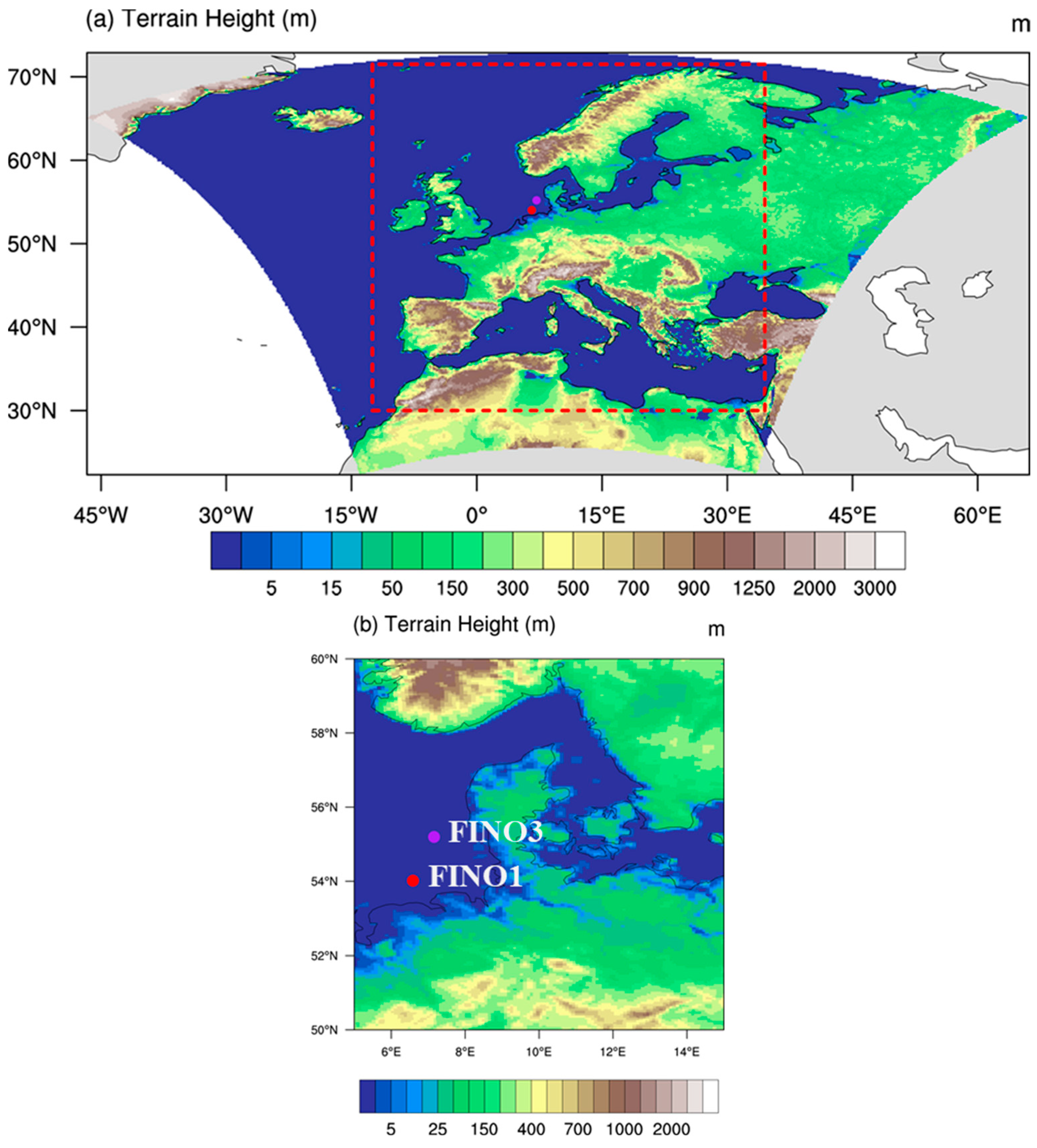
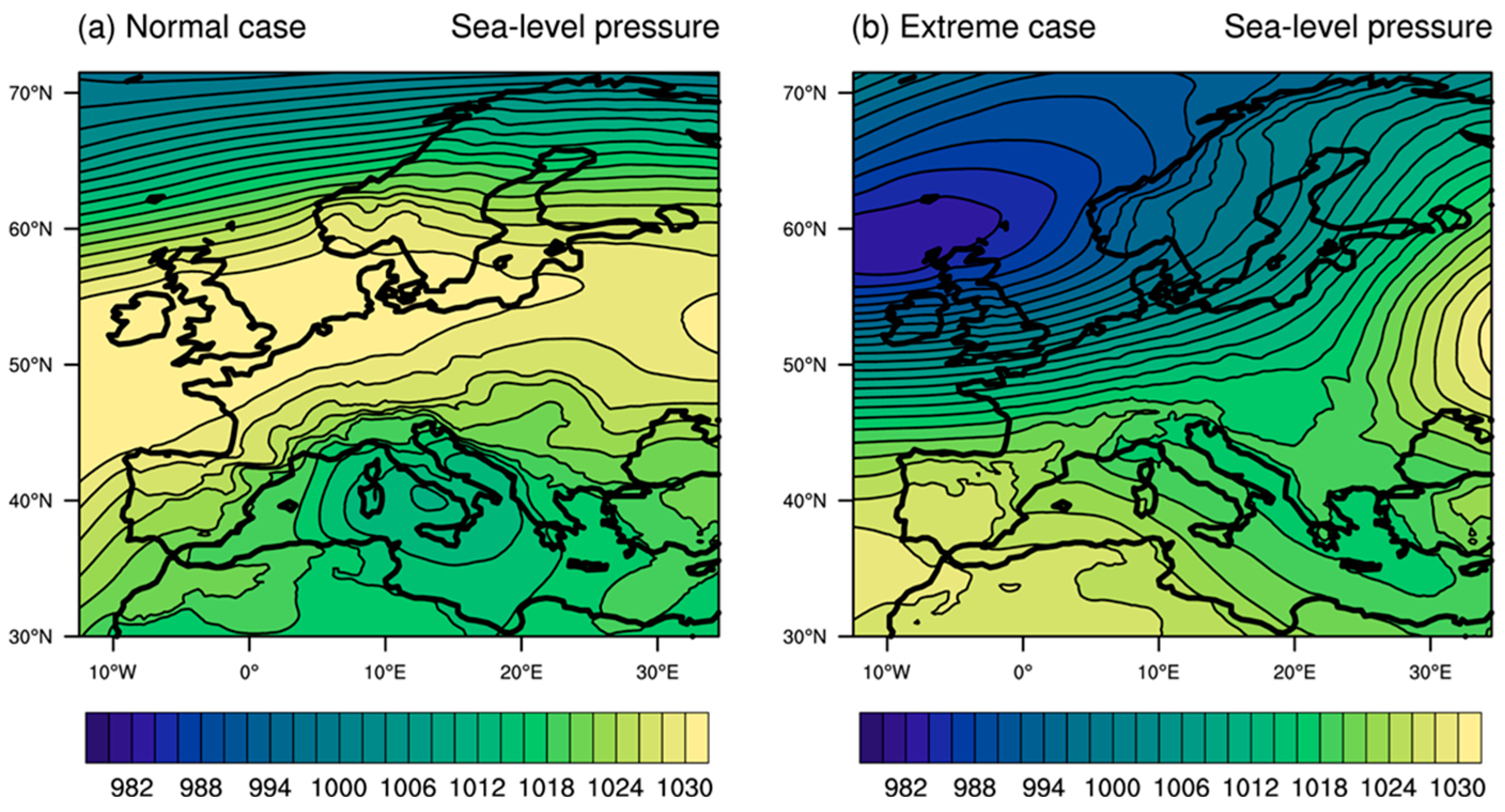
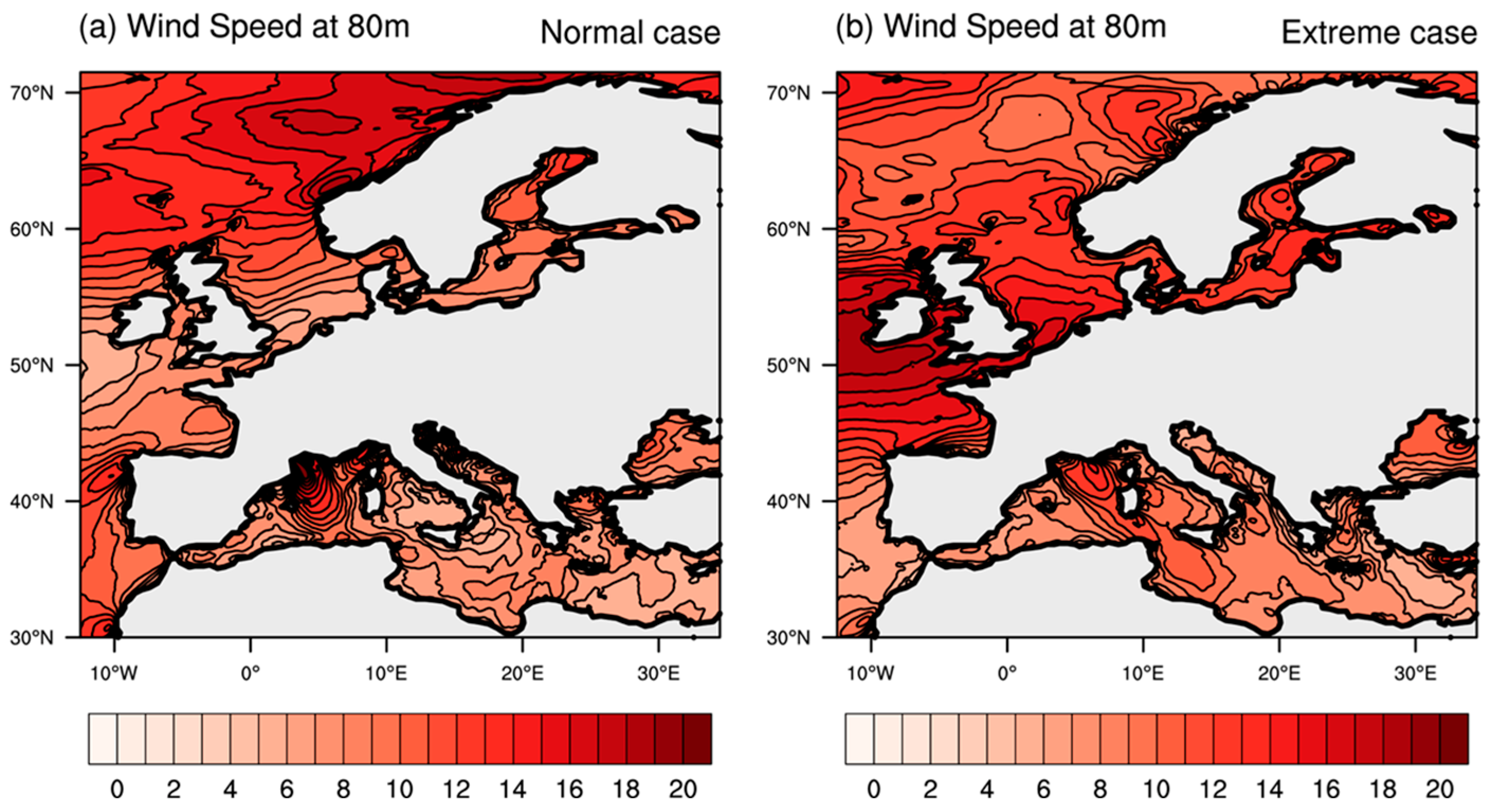
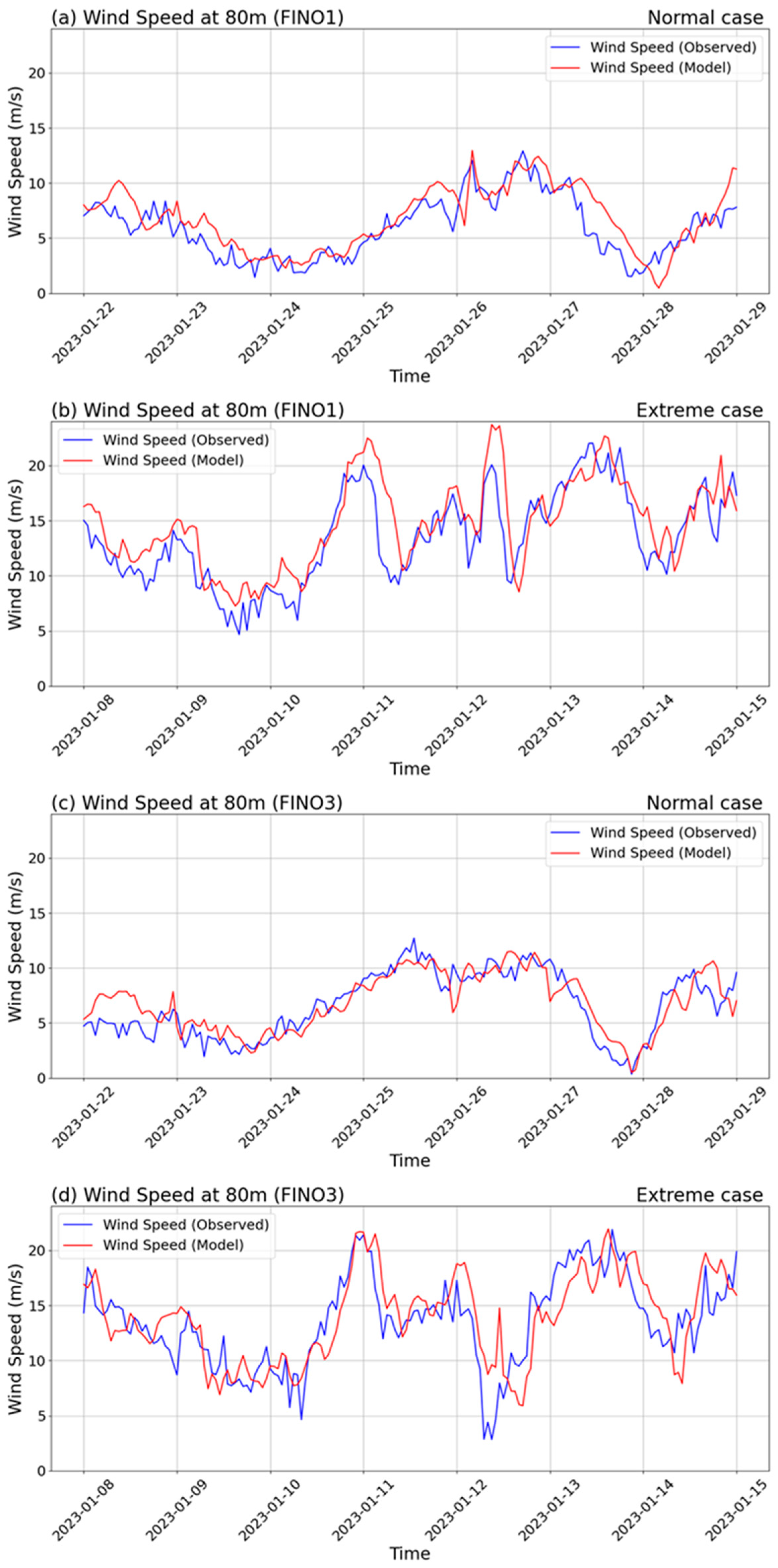

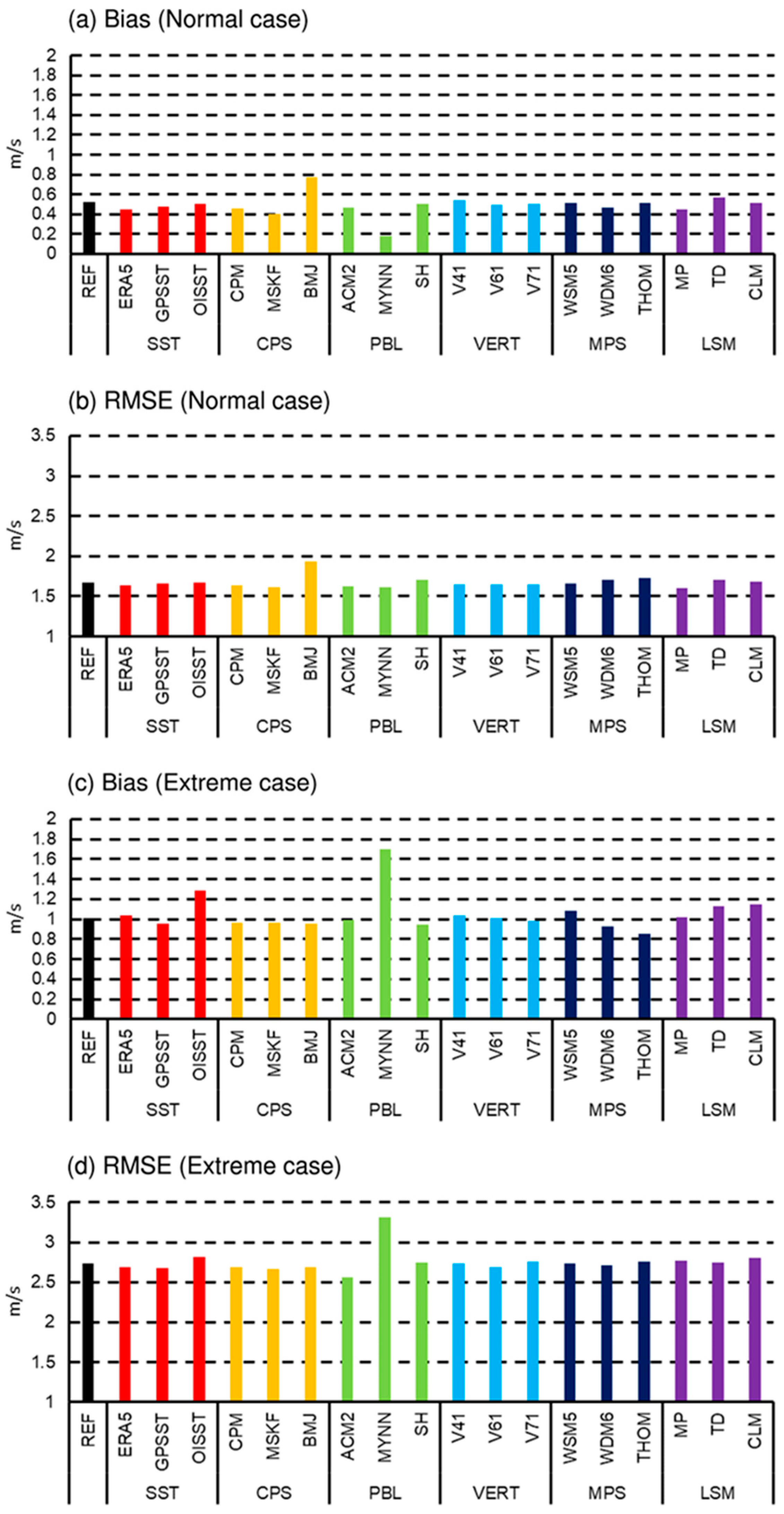
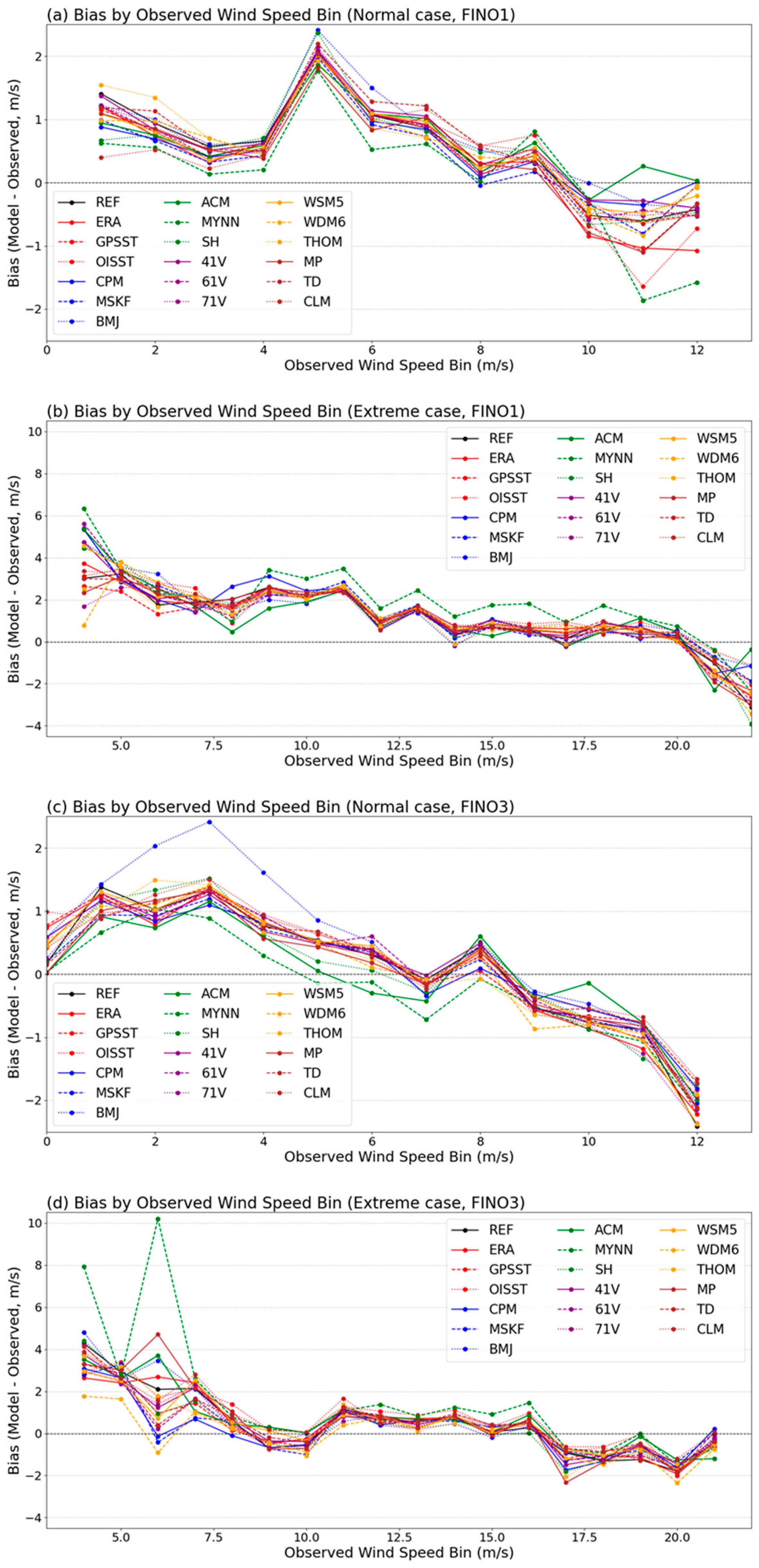
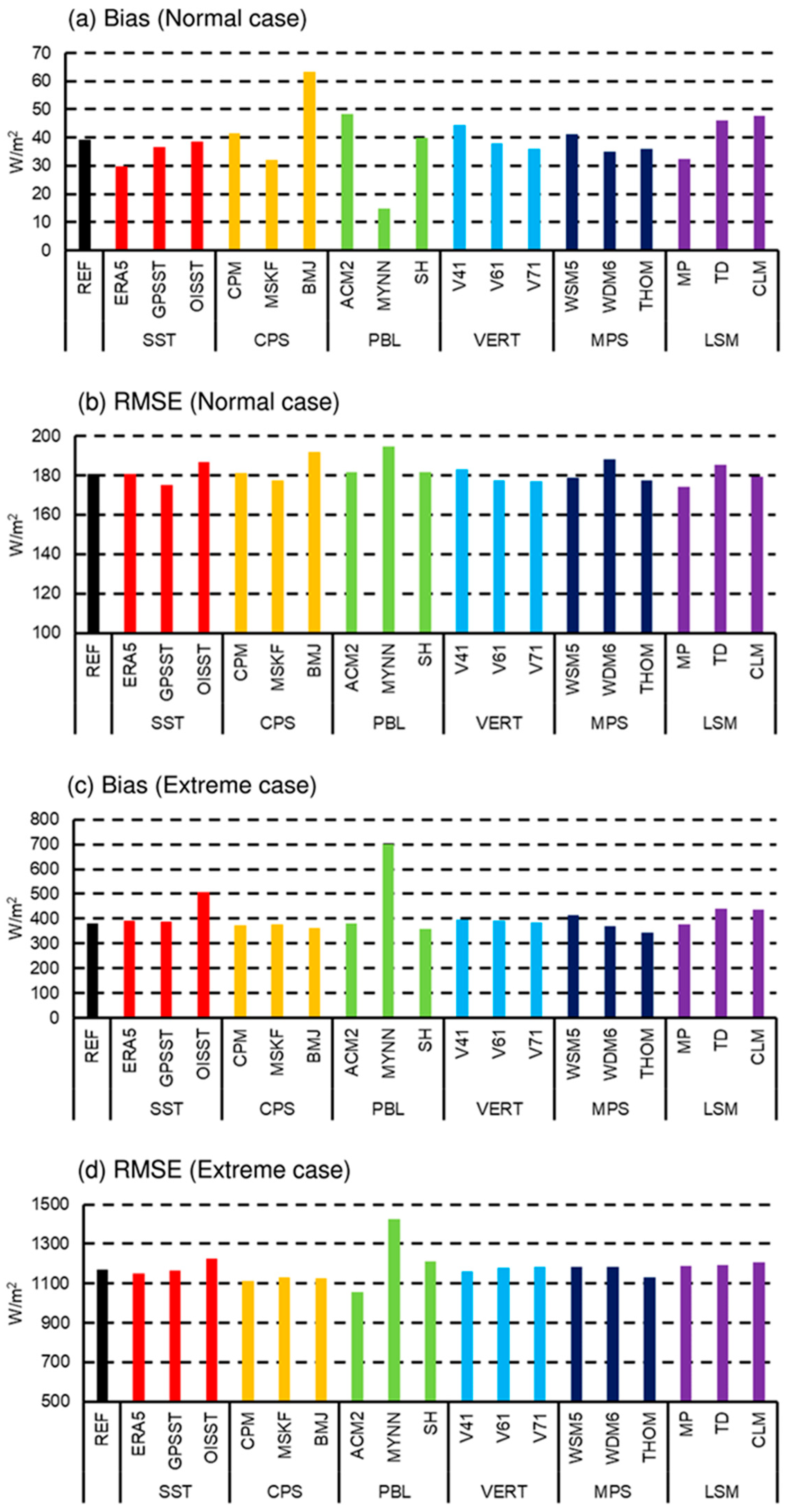
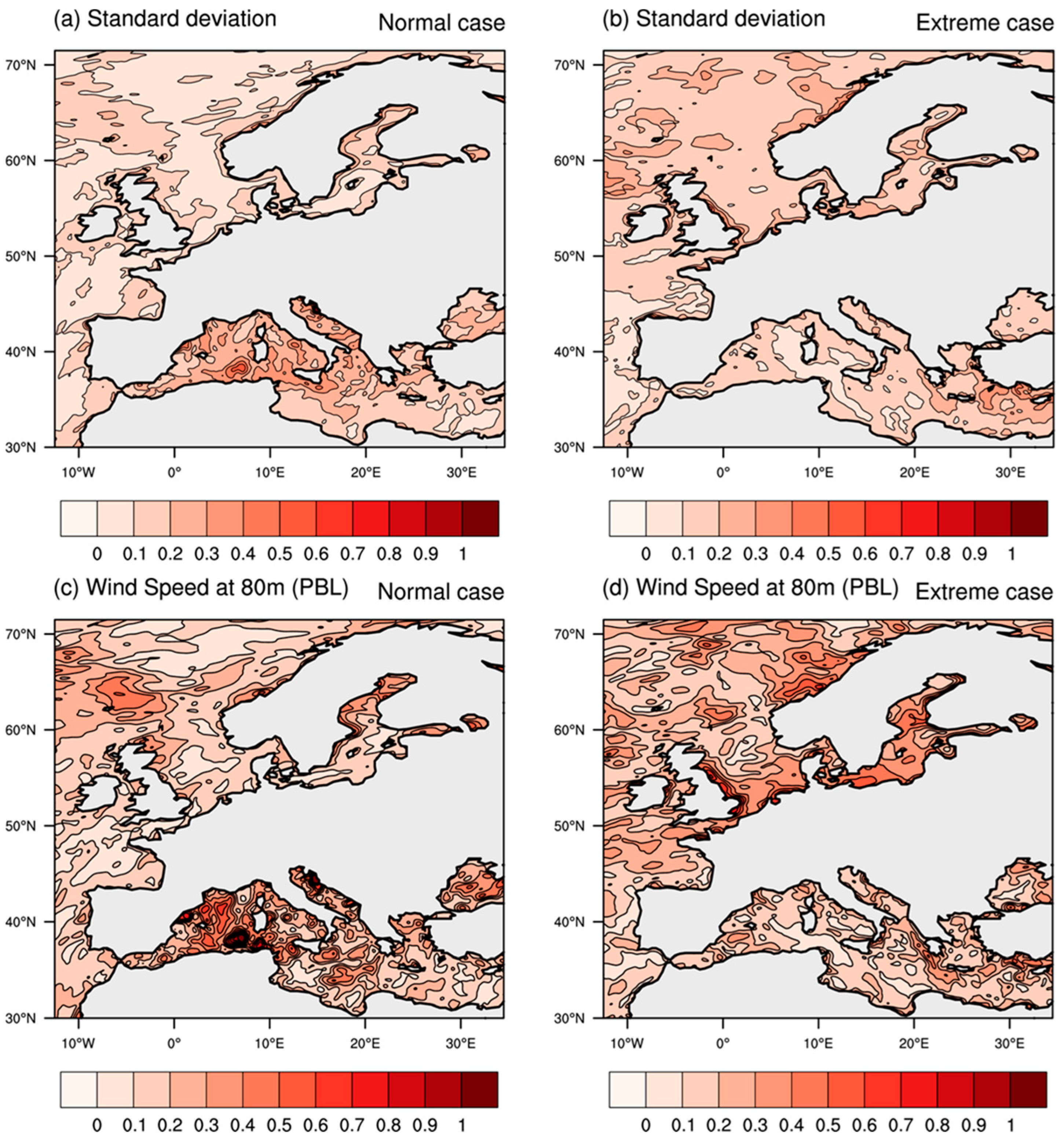
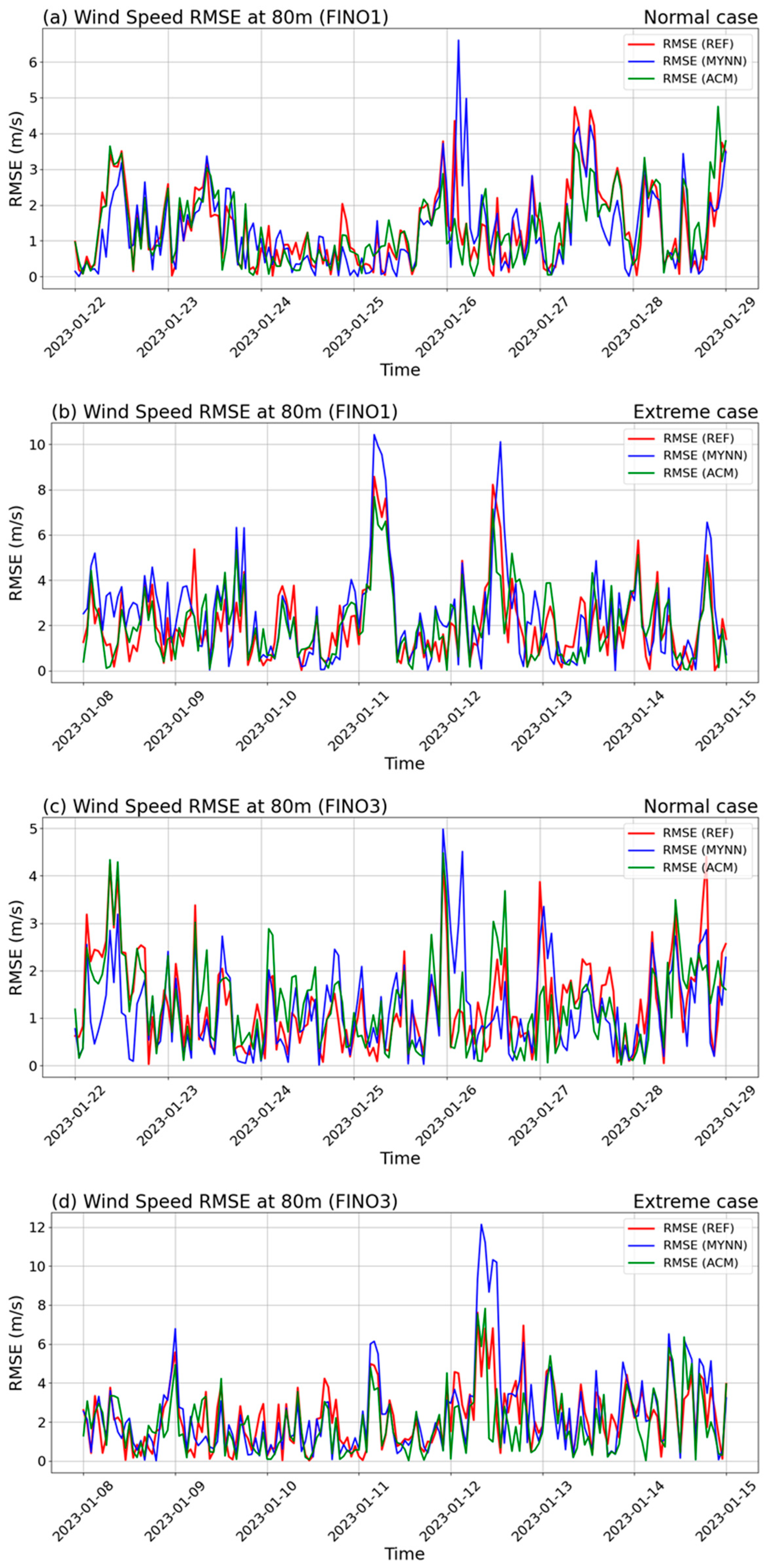
| Model | WRF v4.5.1 |
|---|---|
| Domain (grid points) | Europe (837 × 879) (latitudinal and longitudinal grid points, respectively) |
| Initial and boundary forcing | ERA5 reanalysis (0.25° × 0.25°) |
| Horizontal resolution | 6 km grid spacing |
| Vertical resolution | 51 levels |
| Time step | 30 s |
| Simulation period | 8 days (1 day spin-up + 7 days analysis) |
| SST dataset | OSTIA (6 km resolution) |
| Convection | Kain–Fritsch |
| Planetary boundary layer | YSU |
| Microphysics | WSM6 |
| Land-surface | Unified Noah |
| Surface layer | Revised MM5 |
| Short, longwave radiation | RRTMG |
| Sensitivity Experiment | |
|---|---|
| SST (Sea surface temperature) | ERA5 (0.25° × 0.25°) (ECMWF Reanalysis v5) |
| GPSST (1 km resolution) (Geo-Polar Blended Sea Surface Temperature) | |
| OISST (25 km resolution) (Optimum Interpolation Sea Surface Temperature) | |
| CPS (Cumulus parameterization scheme) | CPM (Convection-permitting model) |
| MSKF (Multi-Scale Kain–Fritsch) | |
| BMJ (Bett-Miller–Janjic) | |
| PBL (Planetary boundary layer) | ACM2 (Asymmetrical Convective Model 2) |
| MYNN (Mellor-Yamada-Nakanishi-Niino) | |
| SH (Shin and Hong) | |
| VERT (Vertical levels) | V41 (41 vertical levels) |
| V61 (61 vertical levels) | |
| V71 (71 vertical levels) | |
| MPS (Microphysics scheme) | WSM5 (WRF Single-Moment 5-class) |
| WDM6 (WRF Single-Moment 5-class) | |
| THOM (Thompson) | |
| LSM (Land surface model) | MP (Noah-MP) |
| TD (Thermal Diffusion) | |
| CLM (Community Land Model version 4) | |
| Variables | Case | Bias | RMSD | PC |
|---|---|---|---|---|
| 500 hPa geopotential height (m) | Normal | 6.552 | 13.165 | 0.997 |
| Extreme | 6.939 | 12.514 | 0.999 | |
| 850 hPa wind speed (m/s) | Normal | 0.054 | 2.298 | 0.920 |
| Extreme | 0.039 | 2.380 | 0.918 |
Disclaimer/Publisher’s Note: The statements, opinions and data contained in all publications are solely those of the individual author(s) and contributor(s) and not of MDPI and/or the editor(s). MDPI and/or the editor(s) disclaim responsibility for any injury to people or property resulting from any ideas, methods, instructions or products referred to in the content. |
© 2025 by the authors. Licensee MDPI, Basel, Switzerland. This article is an open access article distributed under the terms and conditions of the Creative Commons Attribution (CC BY) license (https://creativecommons.org/licenses/by/4.0/).
Share and Cite
Lee, M.; Oh, D.; Kim, J.-Y.; Kim, C.K. Simulating Near-Surface Winds in Europe with the WRF Model: Assessing Parameterization Sensitivity Under Extreme Wind Conditions. Atmosphere 2025, 16, 665. https://doi.org/10.3390/atmos16060665
Lee M, Oh D, Kim J-Y, Kim CK. Simulating Near-Surface Winds in Europe with the WRF Model: Assessing Parameterization Sensitivity Under Extreme Wind Conditions. Atmosphere. 2025; 16(6):665. https://doi.org/10.3390/atmos16060665
Chicago/Turabian StyleLee, Minkyu, Donggun Oh, Jin-Young Kim, and Chang Ki Kim. 2025. "Simulating Near-Surface Winds in Europe with the WRF Model: Assessing Parameterization Sensitivity Under Extreme Wind Conditions" Atmosphere 16, no. 6: 665. https://doi.org/10.3390/atmos16060665
APA StyleLee, M., Oh, D., Kim, J.-Y., & Kim, C. K. (2025). Simulating Near-Surface Winds in Europe with the WRF Model: Assessing Parameterization Sensitivity Under Extreme Wind Conditions. Atmosphere, 16(6), 665. https://doi.org/10.3390/atmos16060665







